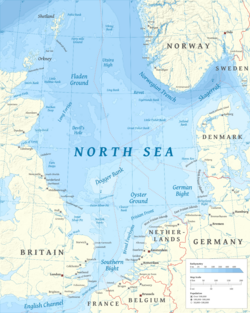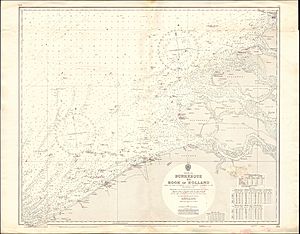Action off Noordhinder Bank facts for kids
Quick facts for kids Action off Noordhinder Bank |
|||||||
|---|---|---|---|---|---|---|---|
| Part of the First World War | |||||||
 North Sea map |
|||||||
|
|||||||
| Belligerents | |||||||
| Commanders and leaders | |||||||
| Strength | |||||||
| 4 naval trawlers 4 destroyers |
2 torpedo boats | ||||||
| Casualties and losses | |||||||
| 1 naval trawler sunk 1 naval trawler damaged 16 dead |
2 torpedo boats sunk 13 dead 46 captured |
||||||
The Action off Noordhinder Bank was a naval battle during the First World War. It happened on May 1, 1915, near the Noordhinder Bank in the North Sea. The battle involved four British fishing boats, called naval trawlers, and four British destroyers. They fought against two German torpedo boats.
The fight started when the German torpedo boats were sent to rescue a seaplane crew. The seaplane had to land because of engine trouble. The German boats also planned to attack the British trawlers. When the British destroyers arrived, the German ships tried to escape. However, both German torpedo boats were sunk.
Losing these two new torpedo boats was a big blow for the German navy in Flanders. It showed German commanders that their ships were not strong enough. They could not protect the coast or attack British ships in the English Channel. After this and other losses, the smaller German torpedo boats were used only for coastal patrols. Larger, stronger torpedo boats were sent to the area.
Contents
Background to the Battle
After some earlier losses, the German navy was careful about sending ships to the coast of Flanders. Admiral Ludwig von Schröder, who led the German forces in Flanders, kept asking for more ships. He wanted submarines and torpedo boats.
Finally, the German navy agreed to send him new ships. These included small coastal submarines and new A-class torpedo boats. These torpedo boats were built in Hamburg. They were then taken apart and moved by land to Antwerp. There, they were put back together.
The new A-class boats were small but fast. They could carry two torpedoes and a gun. The Flanders Torpedo Boat Flotilla was created on April 28, 1915. It was based in Zeebrugge and had 15 of these new boats. Commander Hermann Schoemann was in charge of this group.
Before the Fight
Loss of HMS Recruit
German submarines from Zeebrugge began their operations. On May 1, 1915, a German submarine called UB-6 was at sea. That same day, two British destroyers, HMS Recruit and HMS Brazen, were patrolling. They were near the Galloper lightship, which marked a dangerous sandbank.
At 11:20 a.m., Recruit was hit by a torpedo from UB-6. The destroyer broke in two and sank very quickly. Only 26 crew members were saved by a Dutch ship. Brazen and a British trawler searched for the submarine but could not find it.
Four British trawlers from Great Yarmouth were also in the area. They were looking for a German submarine that had been reported. The trawler Barbados was the lead ship, commanded by Lieutenant Sir James Domville. Around the same time Recruit was sunk, another trawler, Columbia, was attacked by a different submarine. However, that torpedo missed.
German Ships Set Sail
Early on May 1, 1915, two German seaplanes flew from Zeebrugge. They were checking the area around the Thames River. One seaplane had engine trouble and had to land. The other seaplane reported seeing four British trawlers near Noordhinder Bank.
Commander Schoemann then sailed with his torpedo boats, SMS A2 and A6. Their mission was to rescue the seaplane crew and destroy the trawlers. The seaplane crew was rescued by a Dutch ship. They were later taken back to land by a German submarine.
The Battle Begins
Around 3:00 p.m., the two German torpedo boats, A2 and A6, were seen heading towards the British trawlers. They did not have their flags showing at first. When they were about 500 yards away, they raised their German flags. The first German ship fired a torpedo at Columbia, but it missed.
The British trawler Barbados started firing back. Soon after, another torpedo hit Columbia on its left side. Columbia sank quickly. Two more torpedoes passed close to Barbados. The German ships also fired machine guns and artillery at the trawlers.
The other British trawlers, Chirsit and Miura, also began firing from a distance. One of the German torpedo boats turned towards Chirsit. Even though the trawlers were slower and had fewer guns, their crews kept fighting. The captain of Barbados was wounded early in the battle. Lieutenant Domville took over in the wheelhouse. The Germans fired at the wheelhouse, wounding Domville several times.
After about twenty minutes of fighting, one of the German torpedo boats moved away. It started to lose power and stopped. Barbados moved closer, but the Germans got their engine working again. Both German torpedo boats then retreated to the south-south-east.
British Destroyers Arrive
When the loss of Recruit was reported, the Harwich Force sent four British destroyers. These ships, HMS Laforey, Lawford, Leonidas, and Lark, were looking for the submarine that sank Recruit.
Thirty minutes after the German ships retreated, Barbados used its gun and siren to get attention. The destroyer Leonidas arrived from the south-west. With the other three destroyers, they quickly began chasing the two German torpedo boats.
Barbados started searching for survivors from Columbia. They found that Miura had rescued the only survivor, a deckhand. The survivor said that Columbia broke in two when hit and sank almost immediately. He also reported that the Germans kept firing at men in the water.
The four British destroyers fired at the German torpedo boats from a distance. They sank both German ships about an hour after starting to fire. The destroyers rescued 46 German crew members out of 59. The rescued Germans said that three British prisoners from Columbia had been locked below deck on one of their torpedo boats. These prisoners were not released when the German ship sank and were lost. Commander Schoemann was among the German casualties. The British destroyers were not damaged.
Aftermath of the Battle
Casualties
The British lost the trawler Columbia, and Barbados was damaged. Columbia had 16 crew members killed, with only one deckhand rescued.
The Germans lost both torpedo boats, A2 and A6. Thirteen German sailors were killed, including Commander Schoemann. Forty-six German crew members were rescued and taken prisoner.


